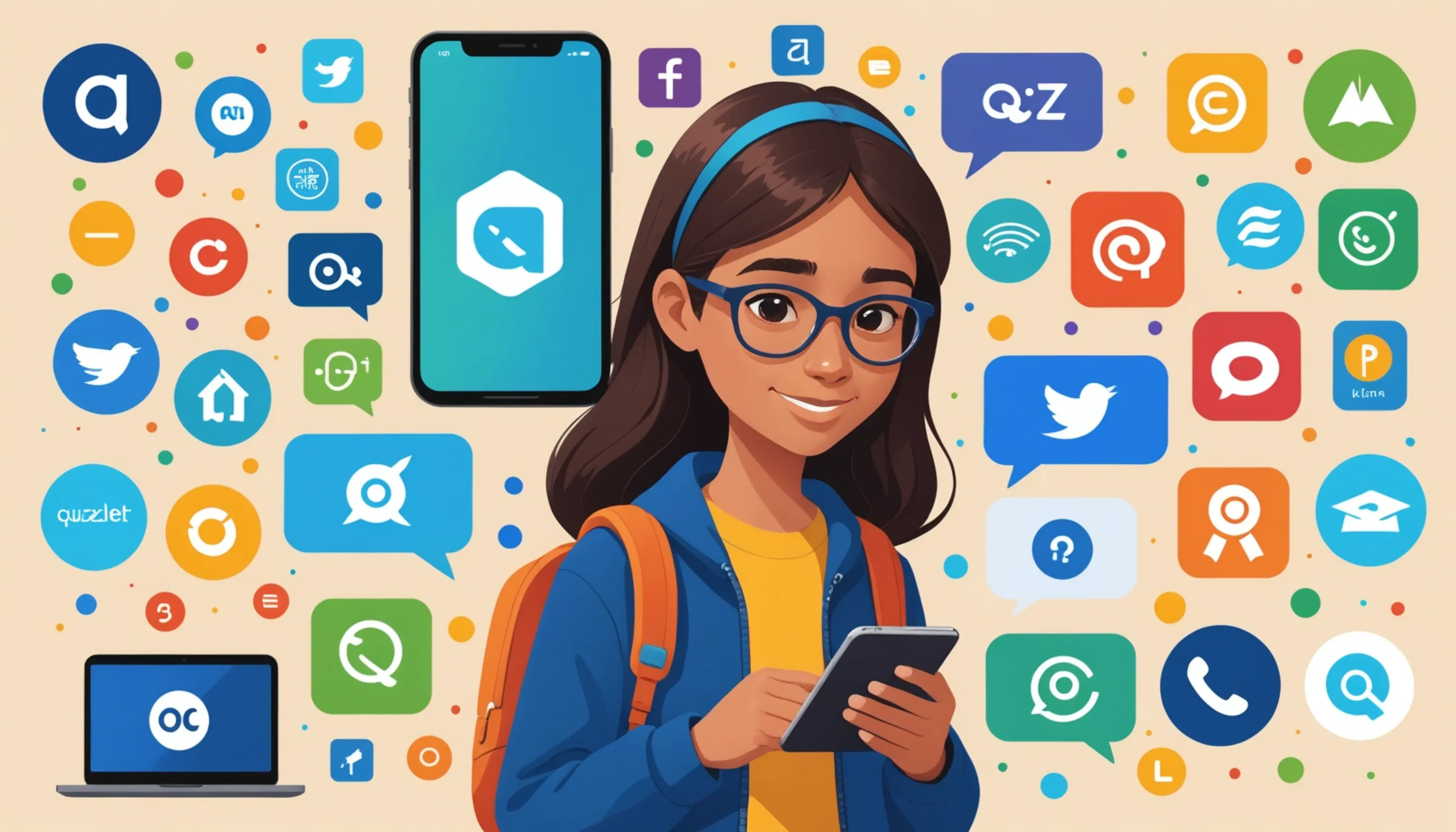Educational Apps for Meaningful Screen Time
 HvWHenry van Wagenberg
HvWHenry van Wagenberg
Top Educational Apps for Meaningful Screen Time
In today's digital age, finding educational apps that promote meaningful screen time is essential for teenagers. These apps not only provide entertainment but also enhance learning and skills development. Some of the top apps include:
- Khan Academy - Offers a wide range of subjects with interactive lessons.
- Duolingo - Engaging language-learning platform with gamified lessons.
- Quizlet - Helps students study through flashcards and quizzes.
By incorporating these apps into daily routines, parents and teachers can ensure that screen time is productive and enriching.
Benefits of Educational Apps for Teenagers
Educational apps offer numerous benefits for teenagers, transforming screen time into a productive and enriching experience. Firstly, they provide personalized learning opportunities. Many apps adapt to the user's learning pace, allowing teenagers to grasp concepts more effectively. This tailored approach helps in addressing individual strengths and weaknesses, fostering a deeper understanding of the subject matter.
Secondly, educational apps often incorporate gamification elements, making learning more engaging and enjoyable. Features like rewards, challenges, and interactive quizzes motivate teenagers to participate actively in their education. This increased engagement can lead to improved retention of information and a more positive attitude towards learning.
Additionally, these apps can enhance critical skills essential for the 21st century. For instance, many educational apps focus on problem-solving, creativity, and collaboration. By using these tools, teenagers can develop skills that are crucial not only for academic success but also for future careers.
Moreover, educational apps can promote self-directed learning. Teenagers can explore topics of interest at their own pace, encouraging them to take initiative in their education. This independence fosters a sense of responsibility and helps build confidence.
Finally, many educational apps facilitate communication and collaboration among peers. Features that allow sharing progress and resources can create a supportive learning community, making education a more social experience.
How to Choose the Right Educational App
Choosing the right educational app for teenagers can significantly impact their learning experience. Here are several key factors to consider when making your selection:
- Define Learning Goals: Begin by identifying the specific skills or subjects you want the app to address. Whether it’s math, language learning, or science, knowing your objectives will help narrow down the options.
- Age Appropriateness: Ensure the app is suitable for the teenager's age group. Some apps cater specifically to certain age ranges, making them more effective and engaging for that demographic.
- User Reviews and Ratings: Look for apps with positive feedback from other users. Reviews can provide insight into the app’s effectiveness and user experience, helping you make an informed decision.
- Trial Versions: Many educational apps offer free trials or demo versions. Take advantage of these to explore the app’s features and determine if it aligns with the teenager's learning style.
- Ease of Use: The app should have an intuitive interface that is easy for teenagers to navigate. Complicated apps can lead to frustration and disengagement.
- Offline Accessibility: If internet access is a concern, consider apps that offer offline functionality, allowing teens to learn without needing a constant connection.
By considering these factors, parents and teachers can select the most suitable educational apps that foster meaningful learning experiences for teenagers.

Popular Educational Apps for Teenagers
Several educational apps have gained popularity among teenagers for their engaging content and effective learning methods. Here are some of the most favored options:
- Khan Academy - Offers a wide range of subjects with interactive lessons and practice exercises.
- Duolingo - A gamified language-learning app that makes mastering new languages fun.
- Quizlet - Provides tools for creating flashcards and quizzes to enhance study sessions.
- Coursera - Features courses from top universities, allowing teens to explore various subjects.
These apps not only promote learning but also foster a sense of accomplishment.
Khan Academy
Khan Academy is an exceptional educational platform that has revolutionized the way teenagers learn. Founded in 2008, this nonprofit organization aims to provide free, world-class education to anyone, anywhere. The app features a vast array of subjects, including math, science, history, and the arts, catering to diverse learning needs.
One of the standout features of Khan Academy is its personalized learning approach. The platform allows users to learn at their own pace, offering a tailored experience that adapts to each student's strengths and weaknesses. For instance, if a teenager struggles with a particular math concept, the app provides additional resources and practice exercises to reinforce understanding.
Khan Academy also employs engaging video lessons, which simplify complex topics through clear explanations and visual aids. These videos enable students to grasp challenging concepts more easily, making learning enjoyable and less intimidating.
Moreover, the app includes interactive exercises and quizzes that allow teenagers to test their knowledge and track their progress. This immediate feedback helps reinforce learning and motivates students to improve.
Additionally, Khan Academy's resources are accessible on various devices, including smartphones, tablets, and computers. This flexibility ensures that teenagers can learn anytime, anywhere, fitting education into their busy lives.
Overall, Khan Academy serves as a valuable tool for teenagers seeking to enhance their understanding of subjects and develop a love for learning.
Duolingo
Duolingo is a widely popular educational app designed to make language learning accessible and enjoyable for teenagers. Launched in 2011, it offers a gamified approach to learning over 30 languages, including Spanish, French, German, and Japanese. This engaging platform has attracted millions of users, thanks to its user-friendly interface and effective teaching methods.
One of the key features of Duolingo is its interactive lessons, which combine reading, writing, listening, and speaking exercises. This well-rounded approach helps teenagers develop a comprehensive understanding of the language. The app uses bite-sized lessons, making it easy for users to fit learning into their busy schedules.
Gamification is at the heart of Duolingo's success. Users earn points, unlock levels, and receive rewards for completing lessons, which keeps them motivated and encourages consistent practice. The app also includes a social aspect, allowing teenagers to connect with friends and compete on leaderboards, adding a fun, competitive element to their learning experience.
Moreover, Duolingo's adaptive learning technology personalizes the experience for each user. The app tracks progress and adjusts difficulty levels based on performance, ensuring that teenagers are appropriately challenged without feeling overwhelmed.
Additionally, Duolingo offers a range of features, including a podcast, stories, and discussion forums, enhancing the learning experience. With its engaging content and accessible format, Duolingo serves as an excellent tool for teenagers looking to learn a new language while having fun.

Quizlet
Quizlet is a powerful educational app that has become a favorite among teenagers for its innovative approach to studying and learning. Launched in 2005, Quizlet offers a wide range of study tools, including flashcards, quizzes, and interactive games, making it an ideal platform for mastering various subjects.
One of the standout features of Quizlet is its flashcard system. Students can create their own flashcards or access millions of user-generated sets covering countless topics. This flexibility allows teenagers to tailor their study materials to suit their specific needs, enhancing retention and understanding.
In addition to flashcards, Quizlet provides various study modes, such as Learn, Test, and Match, each designed to reinforce knowledge in different ways. The Learn mode adapts to the user’s progress, focusing on areas where they may need more practice. This personalized learning experience keeps students engaged and motivated.
Quizlet also encourages collaboration through its group study feature, allowing users to share flashcard sets with classmates and study together. This social aspect fosters a sense of community and makes studying more enjoyable.
Moreover, the app is accessible on multiple platforms, including smartphones, tablets, and computers, enabling teenagers to study anytime and anywhere. The ability to study on-the-go fits seamlessly into their busy schedules, making it a convenient choice for effective learning.
Overall, Quizlet serves as an invaluable tool for teenagers seeking to enhance their study habits and improve their academic performance.
Strategies for Managing Screen Time
Managing screen time effectively is crucial for teenagers to ensure that their usage remains productive and balanced. Here are some effective strategies for parents and teachers:
- Set Clear Limits: Establish daily or weekly screen time limits, ensuring that educational app usage is prioritized over recreational activities.
- Encourage Breaks: Implement the 20-20-20 rule: every 20 minutes of screen time, take a 20-second break and look at something 20 feet away to reduce eye strain.
- Incorporate Offline Activities: Encourage participation in offline hobbies, sports, or family activities to create a balanced lifestyle.
- Create a Schedule: Develop a daily routine that includes specific times for educational app usage, studying, and offline leisure activities.
- Lead by Example: Demonstrate healthy screen time habits yourself, showing teenagers the importance of balance in their daily lives.
By implementing these strategies, screen time can be transformed into a meaningful and enriching experience.
Setting Limits on Screen Time
Setting limits on screen time is essential for promoting a healthy balance between digital engagement and other activities for teenagers. Here are some effective strategies for establishing and enforcing these limits:
1. Establish Clear Rules: Start by discussing and agreeing on specific screen time limits with your teenager. This can include daily or weekly usage caps for both educational and recreational apps. Involving them in the conversation encourages ownership and compliance.
2. Use Technology Wisely: Utilize built-in features on devices that allow you to monitor and restrict screen time. Many smartphones and tablets offer settings to limit app usage and set downtime schedules.
3. Balance Digital and Offline Activities: Encourage a mix of online and offline activities. Designate specific times for studying, playing sports, reading, or engaging in hobbies. This not only reduces screen time but also helps teenagers develop diverse interests.
4. Be Consistent: Consistency is key when enforcing screen time limits. Stick to the agreed-upon rules and discuss any necessary adjustments openly. This helps build trust and understanding between parents and teenagers.
5. Model Healthy Habits: Set a positive example by managing your own screen time. Show that you value offline interactions and activities, reinforcing the importance of balance.
By implementing these strategies, parents can help teenagers navigate screen time effectively, leading to healthier, more fulfilling lifestyles.
Incorporating Breaks During App Use
Incorporating breaks during app use is vital for maintaining teenagers’ focus and overall well-being. Prolonged screen time can lead to fatigue, decreased attention, and even physical discomfort. Here are some effective strategies to ensure that breaks are an integral part of their app usage:
1. Implement the 20-20-20 Rule: Encourage teenagers to take a break every 20 minutes of screen time by looking at something 20 feet away for at least 20 seconds. This simple technique can help reduce eye strain and fatigue.
2. Schedule Regular Breaks: Create a study schedule that includes specific time slots for breaks. For example, after 30 to 45 minutes of app use, suggest a 5 to 10-minute break to stretch, hydrate, or walk around. This keeps their energy levels up and enhances focus.
3. Engage in Physical Activity: Promote physical activity during breaks, such as stretching, yoga, or a quick walk. This not only refreshes the mind but also counters the sedentary nature of screen time.
4. Encourage Mindfulness Practices: Introduce brief mindfulness exercises or breathing techniques during breaks. These practices can help teenagers reset their focus and reduce stress.
5. Make Breaks Social: Encourage teenagers to take breaks with friends or family. This social interaction can provide a mental refresh and promote healthy relationships.
By incorporating these strategies, teenagers can enjoy a more balanced approach to app usage, enhancing their learning experience while maintaining their health.
Encouraging Offline Activities
Encouraging offline activities is crucial for promoting a balanced lifestyle for teenagers, especially in an age dominated by screens. Engaging in offline pursuits can foster creativity, improve social skills, and enhance physical health. Here are several effective strategies for encouraging teenagers to participate in offline activities:
1. Explore Interests: Help teenagers discover their passions by introducing them to various offline activities. Whether it's painting, playing a musical instrument, or engaging in sports, find opportunities that resonate with their interests.
2. Set Family Goals: Create family challenges that involve offline activities, such as hiking, biking, or game nights. This not only strengthens family bonds but also promotes healthy habits.
3. Limit Screen Time: Establish clear screen time limits and encourage teenagers to use the extra time for offline hobbies. This can include reading, gardening, or cooking, allowing them to develop new skills.
4. Encourage Social Interaction: Facilitate opportunities for teenagers to connect with peers through offline activities, such as joining clubs, participating in sports teams, or attending community events. These interactions can help build lasting friendships.
5. Lead by Example: Model a balanced lifestyle by engaging in offline activities yourself. Show enthusiasm for hobbies and interests outside of screens, demonstrating their value.
By fostering a culture of offline engagement, parents and educators can help teenagers develop a well-rounded lifestyle, enhancing their overall well-being and personal growth.
